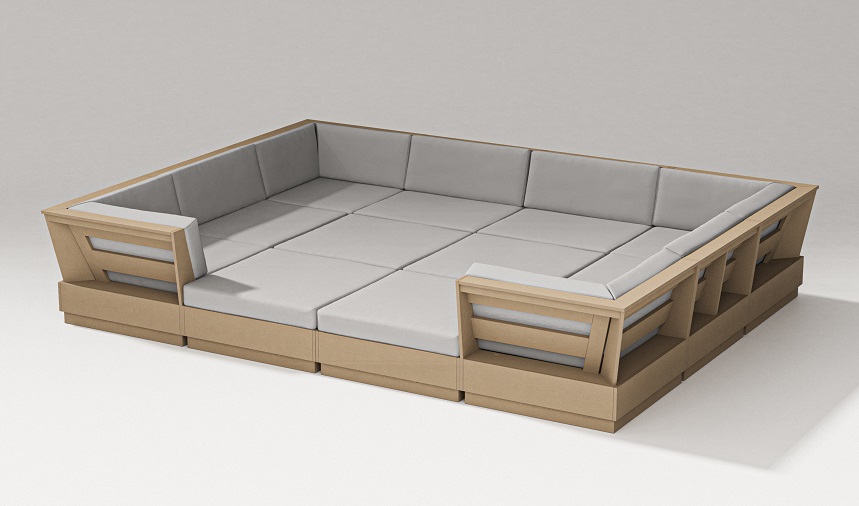Industry experts reveal keys to selling more outdoor furniture


Polywood’s Elevate 12-piece pit sectional features four corner chairs, four armless chairs and four ottomans that suggest a number of possible configurations and uses.
HIGH POINT — Creating an outdoor space that is truly an extension of the home is top of mind for consumers, especially as summer approaches, and those consumers are more than ready to shop in furniture stories to furnish their outdoor spaces.
Furniture Today’s Strategic Insights reported in March that 30% of consumers said they have purchased outdoor furniture in the past two years. Among people who said they were very or somewhat dissatisfied with their outdoor furniture, 61% said they would replace it within the next 12 months.
What does all that shopping mean for the retail sales associate, guiding that consumer to the purchase that best fits their outdoor space?
Five industry leaders in the outdoor category told Furniture Today that while some of the top tips they would offer RSAs would apply to selling any furniture in the store, other tips are specific to knowing the function and features, bells and whistles of outdoor furniture.
Something every RSA needs to know how to do is making a customer feel comfortable, trusting their salesperson to listen to them and help them find the best option, not just the highest sale.
OW Lee’s Vice President of Marketing Leisa Rogers McCollister noted that a genuine, truthful approach should not only be a tactic used when greeting the customer, but also during the entire duration of their visit.
“It’s most important to be knowledgeable, tell the truth and find a way to make the customer feel comfortable,” she said. “I always look for commonality between us, but be sure it’s genuine. Strike up a conversation about something else besides furniture while they are trying out the furniture.”
Part of being authentic means that RSAs takes the time to know what their customer is searching for, and that doesn’t start with a question of budget.
Instead, start with questions such as the space the customer wants to fill, how many people to seat, if there are young children or pets, preferred furniture styles and what qualities are most important. These types of questions provide important information to the RSA, and also create a rapport with the customer.
“It is critical to build trust with your customers; in most cases, buying outdoor furniture is an expensive purchase, and customers want to have confidence in who is selling them,” said Paul Sklar, vice president of wholesale sales at Summer Classics. “Start with qualifying and ask good questions to understand the customer’s needs, their expectations and usage. Budget and spend is last.
“Make sure the customer falls in love with the product,” he added. “The best RSAs listen to the customer.”
Unique outdoor expectations
Todd Wingrove, vice president of sales at Agio USA, believes that the key to selling outdoor furniture successfully is setting reasonable expectations of how products will perform when exposed to the elements of nature.
“Outdoor furniture is often more expensive than indoor because of the additional steps necessary to withstand the elements,” Wingrove said. “Over the past several years, the market has been saturated with lower price points and often poorly crafted products just to hit price points.
“It’s important to alleviate buyer’s remorse when viewing furniture in person as opposed to online. In training, we like to point out the elements that make our furniture solid and able to withstand years of use.”
Customers are often willing to compromise on their wish list in order to find the furniture that has the most important qualities to them. Presenting both the potential pros and cons of a product can assure that the customer is happy with their purchase and doesn’t feel they’ve been lied to.
“For any product, you should have a feature and benefit story,” said Mark Osborne, director, residential sales for MamaGreen. “Every product has something about it that’s great for situation X and not ideal for situation Y. Our ability to speak on behalf of the customer’s specific needs positions us as the expert and builds immediate trust with the customer.
“It gives them the experience that we are invested in what’s best for them first and foremost,” he continued. “Some of the biggest sales can be the result of helping the client avoid a wrong purchase.”
As much as knowledge about a product can influence the buying decision, it is only part of that decision.
“There’s an old saying that people don’t buy features or benefits, they buy emotions,” said Patrick Isaacs, vice president of business development at Polywood. “While it certainly makes it easier to sell when you’re working with an in-demand brand like Polywood that’s built a reputation for the highest quality over three decades, it’s imperative to understand what motivates your customer (and) what will make them feel good about themselves and about the purchase.”
Sklar notes that different customers value different things such as quality, construction, easy care, availability of extra or complimentary pieces, warranties and replacement costs.
“I believe that a good RSA is knowledgeable about the entire category, at different price points and qualities,” he said. “This knowledge enables the RSA to offer choices, remove hesitations and, most importantly, upsell the customer.”





